| |
Printer-friendly version (HTML) |
Employer-provided "Quality-of-life" Benefits for Workers in Private Industry, 2007
by George I. Long
Bureau of Labor Statistics
Originally Posted: October 24, 2007
The National Compensation Survey provides data on "quality-of-life" benefits in its annual benefits summary publications. Although a relatively small percent of workers have access to these kinds of benefits, the data give insight into ways that employers and employees are working toward more family- and environmentally friendly work arrangements.
The Bureau of Labor Statistics National Compensation Survey (NCS) collects data on the percent of employees with access to a wide range of employer-provided benefits.1 Some types of employer-provided benefits are more commonly available than others. As shown in the most recent NCS publication of benefits data, 61 percent of workers in private industry have access to retirement benefits, 71 percent have access to medical plans, and 77 percent have access to paid holidays and paid vacation time.2 By comparison, employee access to various "quality-of-life" benefits is relatively uncommon. (See chart 1.)
Nevertheless, the NCS quality-of-life benefits data give insight into the type of work arrangements that workers value and some employers promote. These benefits have a potential for influencing how people get to work, how they conduct their work, and the extent to which they are connected with their families and fellow workers. Therefore, a closer look at worker access to quality-of-life benefits--by occupation, bargaining status, wage level, establishment size, and area in which the worker is employed--is of value.
Quality-of-life benefits for Private Industry Workers
Chart 1 shows the percent of workers with access to a variety of quality-of-life benefits for all workers in private industry. Long-term care insurance, childcare assistance, and adoption assistance are more than twice as likely to be available than are subsidized commuting, flexible workplace, and employer-provided home personal computer (PC) benefits. (See exhibit for NCS definitions of these benefits.)
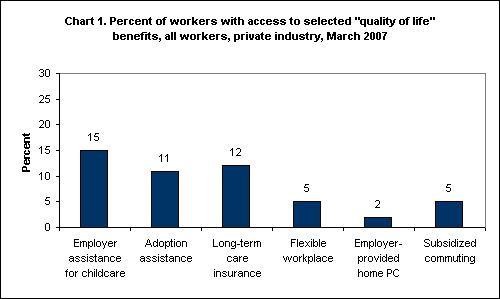
Employer assistance for childcare. Parental participation in the workforce often depends on access to formal childcare arrangements.3 In 2007, 15 percent of workers in private industry had access to employer-provided childcare assistance, which includes funds, on-site or off-site childcare, and resource and referral services. For some workers, childcare needs may be covered by a different employee benefit, dependent care reimbursement accounts, which set aside money to be used to pay for expenses including childcare, eldercare, or services to a disabled dependent. In 2007, 31 percent of workers in private industry had access to dependent care reimbursement accounts.4
Adoption assistance. Of the more than 72 million children under 18 years old in the United States,5 1.6 million (or 2.2 percent) are adopted.6 The U.S. Department of Health and Human Services reports that 51,000 children were adopted with public agency involvement in Fiscal Year 2005.7 The cost of adopting a child can range from $5,000 to $40,000, depending on the agency and source.8 In 2007, 11 percent of all private industry workers had access to employer-provided adoption assistance.
Long-term care insurance. Long-term care insurance has become a sought-after form of insurance as baby boomers prepare for retirement.9 NCS data on access to long-term care insurance includes workers who have access to a group plan as well as those whose employer subsidizes the cost of individual plans. In 2007, 12 percent of private industry workers had access to such plans.
Subsidized commuting. The American public made 9.8 billion trips on public transit in 2005.10 By this measure, public transit use has increased steadily over the past decade. Approximately half of these trips were for commuting to and from work.11 With current concerns about the global impact of modern living, gasoline price uncertainty, and increasing traffic congestion, commuting by public transit may offer some solutions.12 In 2007, only 5 percent of private industry workers had access to commuter subsidies.
Flexible workplace. With the advent of the personal computer and the Internet, it became possible for more types of work, particularly those of professional and technical workers, to be conducted effectively off site, and often from home.13 Increased employee productivity, reduced stress, cost savings, and emergency preparedness have been cited as some of the positive effects of flexible workplace programs.14 Flexible workplace arrangements are sometimes referred to as "teleworking" or "telecommuting," although it is uncertain to what extent flexible workplaces are displacing the traditional daily commute to work.
The NCS definition of flexible workplace is quite restrictive, requiring a formal program; informal plans are not included. In 2007, 5 percent of workers in private industry had access to flexible workplace benefits. By contrast, the Office of Personnel Management reports that approximately 70 percent of Federal workers were eligible to telework during 2005, and 6.6 percent of the Federal workforce (9.5 percent of those eligible) participated in teleworking. Of those who participated, 60 percent teleworked at least 1 day per week.15
Employer-provided home personal computer (PC). Only 2 percent of employers provide workers with a home PC in 2007. This does not include a personal home computer provided by an employer only as part of a flexible workplace arrangement.
Quality-of-life benefits by worker and establishment characteristics
While most subsets of workers followed a similar pattern of access to quality-of-life benefits as did all workers in private industry, some groups showed notable differences. Chart 2 shows employee access to quality-of-life benefits by major occupational group.16 Management, professional, and related occupations had greater access to each of the quality-of-life benefits than did any other occupational group. Sales and office workers were the next most likely to have access to the quality-of-life benefits. Workers in service occupations; natural resources, construction, and maintenance occupations; and production, transportation, and material moving occupations had less access to these benefits.
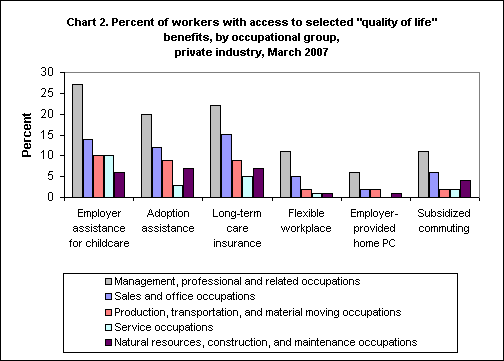
Chart 3 shows that about 15 percent of full-time workers had access to childcare and long-term care benefits, while fewer than 10 percent of part-time workers had access to these benefits. Part-time workers were less than half as likely as full-time workers to have access to adoption assistance.
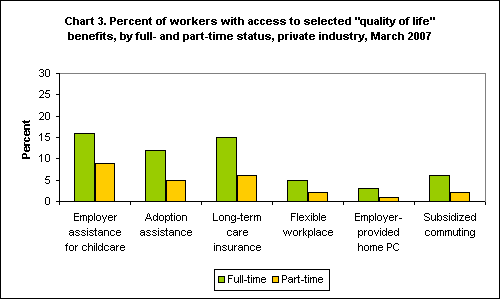
Chart 4 shows that union workers had greater access to childcare assistance, adoption assistance and long-term care insurance than did nonunion workers. Flexible workplace arrangements, while relatively uncommon, are more prevalent among nonunion workers than among union workers, most likely due to union workers’ greater representation in manufacturing and construction occupations, which require work on site, than in professional, managerial, and office and administrative occupations, which had a lower percentage of unionized workers.17
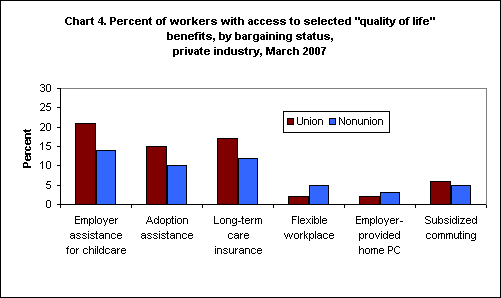
Chart 5 shows that more than 20 percent of workers earning $15 or more per hour had access to childcare assistance, while less than 10 percent of workers earning less than $15 per hour had such access. The disparity among workers by wage level was notable in each of these benefit categories.
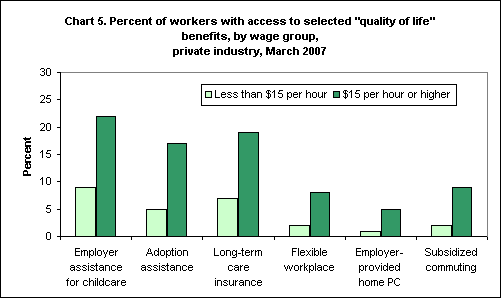
Chart 6 shows that workers employed in establishments with 100 or more workers had much greater access to almost every type of quality-of-life benefit than workers employed in smaller firms. Workers in large firms were 4 to 5 times as likely as workers in smaller firms to have access to childcare, adoption, and long-term care insurance benefits.
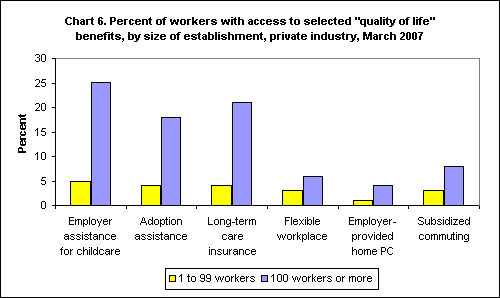
Chart 7 shows that workers in metropolitan areas were more likely to have each of the quality-of-life benefits than did workers in nonmetropolitan areas. Public transit systems are more common in metropolitan than nonmetropolitan areas, which might account for the greater access to subsidized commuting among workers in metropolitan areas.
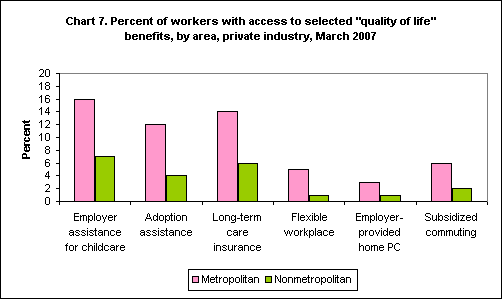
Occupational and establishment characteristics and location of establishment are factors that are most likely to influence the percent of workers who have access to quality-of-life benefits; however, these factors overlap to some extent. For example, workers in metropolitan areas receive average wages of more than $15 per hour, and workers in larger firms earn, on average, more than those in smaller firms. Thus, if workers who earn more than $15 per hour are more likely to receive certain benefits, it could be related to the fact that many of them work in larger firms and in metropolitan areas.18
NOTE: Standard errors have not been calculated for NCS benefits estimates. Consequently, none of the statistical inferences made in this report could be verified by a statistical test.
George I. Long
Economist, Division of Compensation Data Analysis and Planning, Office of Compensation and Working Conditions, Bureau of Labor Statistics.
Telephone: (202) 691-6210; E-mail: Long.George@bls.gov
Notes
1 As defined by the National Compensation Survey, "an employee has access to a benefit plan if the employee is in an occupation that is offered the plan." By definition, either all employees in an occupation have access to a benefit or none has access.
2 National Compensation Survey: Employee Benefits in Private Industry in the United States, March 2007, Summary 07-05 (Bureau of Labor Statistics, August 2007), tables 1, 5, and 19; available on the Internet at http://www.bls.gov/ncs/ebs/sp/ebsm0006.pdf.
3 See "The National Economic Impacts of the Child Care Sector," (The National Child Care Association, Fall 2002), p.2.; available on the Internet at http://www.nccanet.org/NCCA%20Impact%20Study.pdf; also, Women in the Labor Force: A Databook, Report 985 (Bureau of Labor Statistics, May 2005), tables 5-7, pp. 13-21; available on the Internet at http://www.bls.gov/cps/wlf-databook-2005.pdf.
4 National Compensation Survey: Employee Benefits in Private Industry in the United States, March 2007, table 24; available on the Internet at http://www.bls.gov/ncs/ebs/sp/ebsm0006.pdf. See technical note for the NCS definition of dependent care reimbursement accounts.
5 See "America’s Families and Living Arrangements, March 2000", Current Population Report P20-537 (U.S. Census Bureau, June 2001), table C1, detailed tables, on the Internet at http://www.census.gov/population/www/socdemo/hh-fam/p20-537_00.html.
6 See "Adopted Children and Stepchildren: 2000", Census 2000 Special Report CENSR-6RV (U.S. Census Bureau, October 2003), supplemental tables, table 1, "Selected Characteristics of Children of the Householder by Type of Relationship and Sex of Child for the United States: 2000"; available on the Internet at http://www.census.gov/population/cen2000/phc-t21/tab01.pdf.
7 The AFCARS Report: Preliminary FY 2005 Estimates as of September 2006 (13), (U.S. Department of Health and Human Services, Children’s Bureau); available on the Internet at http://www.acf.hhs.gov/programs/cb/stats_research/afcars/tar/report13.htm.
8 For more information on adoption-specific expenses, see Child Welfare Information Gateway, Costs of Adopting: Factsheet for Families (U.S. Department of Health and Human Services, Children’s Bureau); available on the Internet at http://www.childwelfare.gov/pubs/s_cost/s_costb.cfm.
9 For more information, see Jordan Pfuntner and Elizabeth Dietz, "Long-term Care Insurance Gains Prominence," Compensation and Working Conditions Online (Bureau of Labor Statistics, January 28, 2004); available on the Internet at http://www.bls.gov/opub/cwc/cm20040123ar01p1.htm.
10 See "Unlinked Passenger Trips by Mode" (American Public Transportation Association, Washington, DC); available on the Internet at http://www.apta.com/research/stats/ridership/trips.cfm.
11 See "Purpose of Trips by Population Group" (American Public Transportation Association, Washington, DC); available on the Internet at http://www.apta.com/research/stats/ridership/purpose.cfm.
12 "Linking Solutions to Problems: Traffic Congestion and Reliability: Linking Solutions to Problems," prepared for the Federal Highway Administration by Cambridge Systematics, Inc., 100 Cambridge Park Drive, Suite 400, Cambridge, Massachusetts 02140; with Texas Transportation Institute, July 19, 2004.
13 For more information on workers using computers and the Internet, see Computer and Internet Use at Work in 2003, USDL 05-1457 (U.S. Department of Labor), August 2, 2005; available on the Internet at http://www.bls.gov/news.release/pdf/ciuaw.pdf.
14 Status of Telework in the Federal Government: Report to the Congress (U.S. Office of Personnel Management, June 2007), pp. 11-13; available on the Internet at http://www.telework.gov/surveys/2006_TW20Report.pdf.
15 Ibid., pp. 2, 5-8.
16 For recent changes in the NCS occupational classifications, see "Change is coming to the NCS benefits products," on the Internet at http://www.bls.gov/ncs/ebs/ebsm0005.htm.
17 Union Members in 2006, USDL 07-0113 (U.S. Department of Labor), January 25, 2007, table 3; available on the Internet at http://www.bls.gov/news.release/union2.nr0.htm.
18 See National Compensation Survey: Occupational Wages in the United States, June 2005, Bulletin 2581 (Bureau of Labor Statistics, August 2006), table 1; available on the Internet at: http://www.bls.gov/ncs/ocs/sp/ncbl0832.pdf.